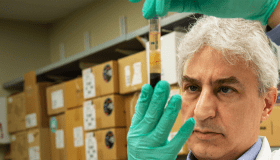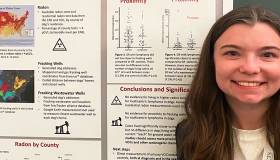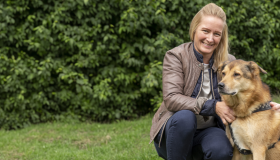
March 24, 2022 — Cancer is a scary word for pet parents. In survey after survey, cancer consistently is cited by pet owners as a major, if not the major, health concern when it comes to their companion animals.
The good news is advances in therapy over the last 40 years have helped give pets a fighting chance to enjoy a high quality, longer life.
However, cancer treatment is almost as frightening to pet owners as getting a cancer diagnosis for their pet. Part of this understandable concern is some cancer therapies can be financially, emotionally and physically draining.
Understanding the whats, hows and whys behind the most used cancer treatments – surgery, chemotherapy and radiation therapy – can help alleviate this anxiety. Let’s unpack these questions so owners can be armed with the latest knowledge in order to make the best decisions for their furry friend when cancer is diagnosed.
Cancer terminology
It might be good to stop here and review some cancer terminology before moving on. Lots of terms are used when discussing cancer in pets and it can get confusing. Here are a few of the most common pet owners may hear (definitions based on WSAVA Oncology Working Group glossary).
- Neoplasia/neoplasm – uncontrolled growth of cells, typically forming a mass. A neoplasm can be benign or malignant.
- Benign – a neoplasm that doesn’t spread to other areas of the body.
- Malignant - a neoplasm that can spread to other areas of the body.
- Tumor – any abnormal lump, bump, growth or swelling. A tumor can be a neoplasm, and benign or malignant, or not a neoplasm at all, e.g., an abscess.
What is cancer?
By definition, cancer is a malignant neoplasm with the ability to spread to other tissues (metastasis) being a key feature.
Cancer is related to uncontrolled growth of a particular tissue but, at its core, cancer is a genetic disease. Cancers form when the checks and balances of cell growth, as dictated by the genetic code (DNA) of an animal, are disrupted.
Cancer is not one disease, but many. There are hundreds of different types of cancer, and each has unique characteristics. Thinking of cancer this way can help us understand why one cancer type is sensitive to radiation therapy while another can only be treated with chemotherapy.
Cell biology basics
Cells go through a cycle of division in order to replicate and replace themselves. Cell division is important for growth in young individuals and to repair damaged tissue. Cancer cells tend to divide faster than normal cells, and while this favors cancer growth and spread, it’s also a weak spot that can be exploited (more on this shortly).
The process of cell duplication often is referred to as the cell cycle. The cell cycle is divided into several phases and a specific step in cell division occurs in each phase. Many chemotherapy agents target specific phases of the cell cycle.
How common is cancer in dogs and cats?
Roughly 12 million dogs and cats are diagnosed with cancer each year. Statistics show cancer is a top cause of death in both cats and dogs. Odds are that pet owners will be faced with this disease at some point in their pet’s life.
Although we have a good idea about the total numbers of pets affected by cancer, we don’t know exact numbers for each cancer type. For example, a question we often hear is “How many dogs get hemangiosarcoma each year?” Unfortunately, we don’t know this exact number because many dogs might die suddenly with no diagnosis. In addition, veterinary databases in the United States aren’t linked to each other, making it hard to find total numbers of diagnoses for a particular disease. This can be frustrating for owners, researchers and veterinarians alike.
However, we do have information from publications and some databases that give us an idea of the characteristics of pets with cancer, prognosis and treatment successes and potential risk factors.
Cancer treatment
Now that we’ve reviewed terminology, cancer basics, the cell cycle and cancer in our pets, let’s dive into various types of cancer treatments.
Surgery
Surgery as a treatment for cancer dates back to the ancient Egyptians. In fact, it was the only treatment option for centuries. Surgery has been a mainstay of cancer treatment in veterinary medicine for more than 100 years.
Surgery continues to be an important and common cancer treatment for animals. Many cancers (and benign tumors) can be removed completely with surgery. Surgery also is used as an adjunct to other cancer therapies.
Radiation therapy
Radiation was first used to treat animals with cancer more than 100 years ago. Radiation works by disrupting DNA inside cells which in turn, prevents cells from dividing. Cells that are rapidly dividing (such as cancer cells) are most susceptible to the effects of radiation, but any cell can be damaged (some permanently).
Most of us probably have a very negative image of radiation – we often think of nuclear weapons or nuclear accidents. Additionally, most of us know exposure to radiation can cause cancer. However, the way radiation is used to treat cancer is different from these types of exposures in many ways.
Radiation can be used as the primary mode of treatment for cancer. It also can be used in combination with other modalities such as surgery. Radiation can be used to shrink a tumor prior to surgery, and it also can be used post-surgery as well.
Radiation can be coupled with chemotherapy to treat cancer. Some agents (radiosensitizers) make cells more susceptible to the effects of subsequent radiation therapy.
Radiation therapy usually is administered through an external source, similar to an X-ray machine. Sometimes, radioactive material is implanted into a tumor. Although not common in veterinary medicine, a radioactive substance may be given by mouth or injected into the bloodstream. Radioactive iodine therapy used to treat hyperthyroidism in cats works this way.
Chemotherapy
Chemotherapy is the broadest category of treatment for cancer. Many different agents fall into this category. Some medications, such as prednisone, are used to treat diseases other than cancer. Other agents, such as doxorubicin, are only used in cancer patients.
Some chemotherapy agents disrupt different phases of the cell cycle, while others disrupt specific processes required for cell division. This allows oncologists to rotate through different types of drugs at different times to treat certain cancers.
For example, vincristine, a common chemotherapy drug, disrupts tubulin which is part of a cell’s “skeleton” and a component of cell division. Vincristine often is coupled with doxorubicin, a drug that inhibits an enzyme required for DNA duplication which is required for a cell to divide. Combining these drugs attacks a cancer cell in two different ways.
Because cancer cells are dividing quickly, they’re more sensitive to chemotherapy. Rapidly dividing normal cells also are likely to be affected by chemotherapy agents. Examples include cells in the bone marrow and intestinal tract, which partially explains common side effects of treatment such as diarrhea and low white blood cell counts.
Developing chemotherapeutic agents with greater specificity for cancer cells remains an area of intense research in both human and veterinary medicine.
On the horizon
Although we’ve made great strides in treating pets with cancer we still have a long way to go. Many of Morris Animal Foundation’s funded studies, both past and present, focus on finding new and innovative treatments for cancer that are more effective while reducing side effects.
Immunotherapy
One new type of cancer therapy getting a lot of attention is immunotherapy, which harnesses the power of an individual’s immune system to attack cancer. Cancer cells have developed a variety of strategies to make themselves invisible to the immune system. The goal of immunotherapy is to overcome these defenses. The Foundation has several funded studies in progress looking at new immunotherapy strategies in companion animals, including horses.
Personalized chemotherapy
Customizing treatments based on an individual’s or a tumor’s genetic makeup, tumor type and lifestyle considerations is entering the mainstream in human medicine. It’s often referred to as personalized or precision medicine. Oncologists using this strategy reject a one-size-fits-all approach to cancer treatment, focusing instead on the unique aspects of each individual’s cancer.
The idea of personalized chemotherapy is gaining ground in veterinary medicine as well. The Foundation has funded a few studies focused on tailoring chemotherapy to the individual. We expect this to be an exciting new avenue of cancer research.
New drugs, new diagnostics
Finding new and different chemotherapy agents, and the early detection of cancer are both hot areas of research. The Foundation is funding many new studies exploring everything from using phytomedicines to nanoparticles to finding early biomarkers of disease. It’s early days for these new studies, but we’re hopeful funding will result in better outcomes for pets diagnosed with cancer.
The Golden Retriever Lifetime Study
This first-of-its-kind study is focused on learning more about risk factors for cancer in dogs. Now in its 10th year, the Study is following 3,044 golden retrievers throughout their lives, collecting data and biologic samples for analysis. The team is beginning to analyze the data and hopes to look for patterns that could hold clues to cancer development and give direction on where to target future cancer research.
Learn more about what we’re funding and how you can make a difference. Cancer shortens the lives of too many pets but, working together, we can change the ending to the story!
Other resources:




